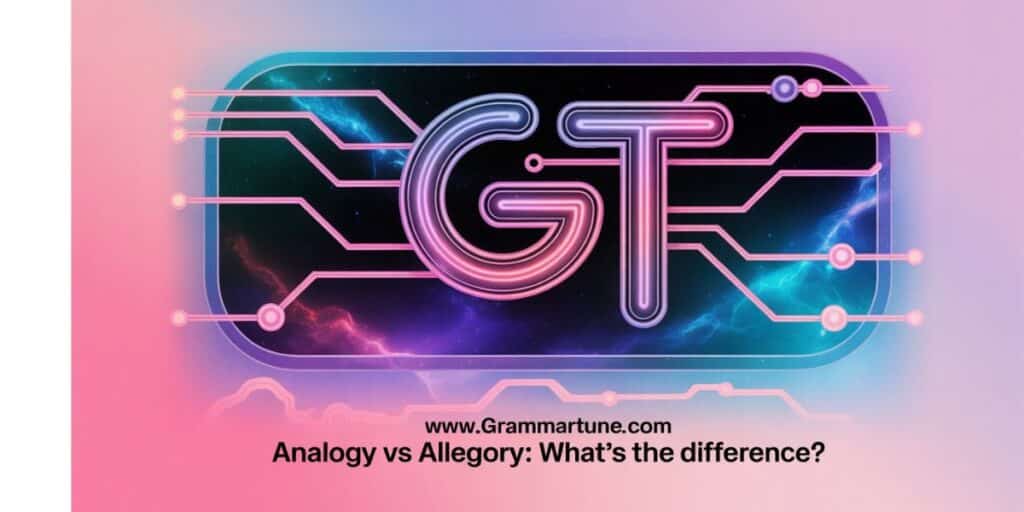Hooked on words, but tangled in meaning? You’re not alone—analogy and allegory trip up even seasoned writers. This guide breaks down the key differences so you can master both with confidence.
🔍 Core Concepts
🧠 Analogy
An analogy entails taking two things for comparison, highlighting the similar aspects in them. This is akin to saying, “Understanding a computer is like understanding the human brain.”🖥️🧠 An analogy this clarifies the more complicated ideas by comparison to something that is known.
📖 Allegory
An allegory conveys political or moral truths through the use of characters and events as symbols. George Orwell’s Animal Farm allows certain farm animals to be used to represent people associated with the Russian Revolution.🐷🐴
🌊 Metaphor
A metaphor asserts that one thing is another and therefore similar in one or more respects. For example, “Time is a thief” suggests that time steals from our lives.⏳
🏛️ Origins and Background
🧾 Origins of Analogy
The term analogy, from the Greek analogia, refers to proportion and correspondence, and has been used for a long time to draw the comparison that aids in the understanding.📚
🏛️ Origins of Allegory
Allegory is of ancient Greek origin, with some of its earliest traces found in Homer. Over time, it became the means of an important literary discourse to forge symbolic tales to convey deeper meanings.📖
🧬 Origins of Metaphor and Analogy
Whether it be metaphor or analogy, both have their origins in ancient times. A metaphor equates two things with no explanation, while an analogy explicates one idea by pointing to another. Enriching the language and communication is their joint survival. 🗣️
⚖️ Comparisons and Differences
🔄 Analogy vs Allegory
| Aspect | Analogy | Allegory |
| Purpose | To explain by comparison | To convey hidden meanings through storytelling |
| Form | Direct comparison | Symbolic narrative |
| Example | “Life is like a journey” | Animal Farm by George Orwell |
🧠 Metaphor vs Analogy: The Differences
- Focus: A metaphor equates two things directly, while an analogy explains one thing by comparing it to another.
- The Structure: Metaphors are compact; often but a single phrase; analogies are more complex in their comparisons.
- In Essence: Metaphors give life to the imagery; analogies clarify through comparison
✍️ Usage in Writing and Communication
📝 How to Use Analogy and Allegory in Sentences
- Analogy: “Explaining a complex idea is like untangling a knot.”
- Allegory: “In The Tortoise and the Hare, the tortoise represents perseverance.”
🖋️ Using Metaphor and Analogy in Writing and Communication
- Identify Your Goal: Determine if you want to clarify (analogy) or symbolize (allegory).
- Choose Your Source Material: Select familiar concepts for analogies; rich narratives for allegories.
- Ensure the Comparison Makes Sense: The comparison should enhance understanding.
- Keep it Fresh (but Not Forced): Use original comparisons to maintain interest.
- Consider the Context: Ensure your choice fits the tone and purpose of your writing.
📚 Examples
📖 Examples of Analogy and Allegory Used in Literature and Communication
- Analogy: “As surely as a sword is a warrior’s tool, so a pen is the weapon of a writer.”
- Allegory: “In the Chronicles of Narnia, Aslan symbolically represents Christ.”
🧩 Examples in Context
- Metaphor: “The classroom is considered to be similar to a zoo.”
- Analogy: “We can compare the student to a caterpillar being changed into a butterfly as she nibbles, learns, and metamorphoses in educational engagement
⚠️ Common Issues and Clarifications
🚫 Common Mistakes to Avoid When Using Analogy and Allegory
- Analogy: Avoid forced comparisons that confuse rather than clarify.
- Allegory: Keep story theories as straight and clear as possible.
🔍 What Are the Differences Between Allegory and Analogy?
Allegory is a narrative that is complete and conveyed through symbolic meanings.
Analogy is a comparison used for the purpose of explaining or elucidating.
🤔 Why Do People Commonly Confuse Allegory and Analogy?
Both compare something; it is in the goal and way of achieving it that the major difference lies between contrast and comparison. Admirable ability not to be confused.
✅ What Are Some Ways to Make Sure You Don’t Confuse Allegory and Analogy?
- Understand Their Purposes:Make sure you know for sure if you’re explaining (analogy) or symbolizing (allegory).
- Analyze the Structure: Whether the work is a direct one-on-one comparison or a symbolic narrative.
- Practice: Read examples of each to become familiar with their forms and functions.
Conclusion
The Analogy vs Allegory: What’s the Difference? debat which one lands superior to the other is purpose and structure. Different from allegories, analogies emphasize the underlying moral, political, or spiritual meanings.
Yet, what unites them is comparison. What distinguishes them is their differentiation of outcomes between clarity and storytelling. Pre Suggested practical applications of when to employ one or the other will sharpen your skills in communication and writing. In fact, you are everywhere growing to become a more expressive phenomenon.
FAQ,S
What is an analogy?
It’s a comparison used to explain or clarify an idea by showing similarities.
How does an allegory work?
It tells a story where characters and events symbolize deeper meanings.
Is a metaphor the same as an analogy?
Nope! A metaphor equates two things directly; an analogy explains through comparison.
Why do people mix up analogy and allegory?
Because both involve comparisons—but their structure and purpose differ.
How can I avoid confusing them?
Focus on context—use analogies to clarify, allegories to symbolize.

Joulia, a seasoned wordsmith and grammar enthusiast, brings over a decade of blogging expertise to Grammar Tune. With a keen eye for linguistic precision and a passion for making complex grammar concepts accessible, he has helped thousands of readers enhance their writing skills. His engaging teaching style and practical approach to language learning have made him a trusted voice in the online grammar community.







